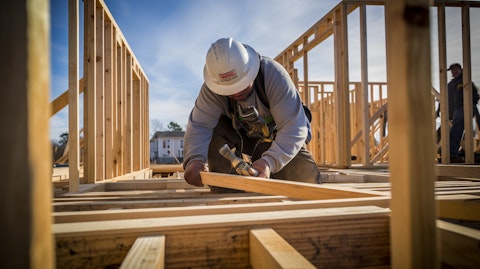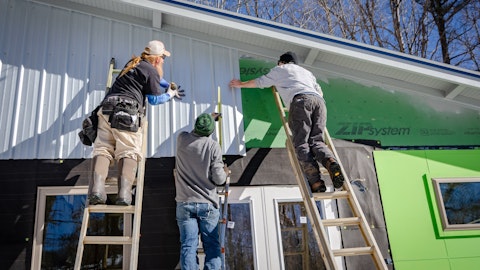LGI Homes, Inc. (NASDAQ:LGIH) Q4 2023 Earnings Call Transcript February 20, 2024
LGI Homes, Inc. misses on earnings expectations. Reported EPS is $2.19 EPS, expectations were $2.69. LGIH isn’t one of the 30 most popular stocks among hedge funds at the end of the third quarter (see the details here).
Operator: Welcome to the LGI Homes Fourth Quarter 2023 Conference Call. Today’s call is being recorded, and a replay will be available on the company’s website at www.lgihomes.com. [Operator Instructions]. I’ll now turn the call over to Josh Fattor, Vice President of Investor Relations. Please go ahead.
Joshua Fattor: Thanks, and good afternoon. I’ll remind listeners that this call contains forward-looking statements, including management’s views on LGI Homes business strategy, outlooks, plans, objectives and guidance for future periods. Such statements reflect management’s current expectations and involve assumptions and estimates that are subject to risks and uncertainties that could cause those expectations to prove to be incorrect. You should review our filings with the SEC for a discussion of the risks, uncertainties and other factors that could cause actual results to differ from those presented today. All forward-looking statements must be considered in light of related risks and you should not place undue reliance on such statements, which reflect management’s current viewpoints and are not guarantees of future performance.
On this call, we’ll discuss non-GAAP financial measures that are not intended to be considered in isolation or as substitutes for financial information presented in accordance with GAAP. Reconciliations of non-GAAP financial measures to the most comparable measures prepared in accordance with GAAP can be found in the press release we issued this morning and in our annual report on Form 10-K for the period ended December 31, 2023, that we expect to file with the SEC later today. This filing will be accessible on the SEC’s website and in the Investor Relations section of our website. I’m joined today by Eric Lipar, LGI Homes’ Chief Executive Officer and Chairman of the Board; and Charles Merdian, Chief Financial Officer and Treasurer. I’ll now turn the call over to Eric.
Eric Lipar: Thanks, Josh. Good afternoon, and welcome to our earnings call. We are pleased to report that we delivered a strong fourth quarter and successfully achieved all of our operational and financial guidance targets for the full year. We also laid the foundation for considerable community count growth and continued profitability for many years to come. As we prepared for today’s call, we reflected on our original full year guidance from February of last year. Looking back, it’s worth highlighting how all our teams across the country navigate the headwinds, executed our strategy and outperformed our initial expectations. At the beginning of last year, we expected to close between 6,000 and 7,000 homes. We delivered 6,729 homes, the high end of our original guidance and an increase of 1.6% year-over-year.
We expected ASPs between $335,000 and $350,000 and we exceeded that range. We generated revenue of $2.4 billion, an increase of over 2% compared to last year, making us one of the few public homebuilders who delivered year-over-year growth in both closings and revenue in 2023. The trend of outperformance continued when it came to our profitability targets. At this time last year, we expected gross margin to range between 21% and 23% and our actual results was at the top end of that range. We expected adjusted gross margin between 22.5% to 24.5%. Through a continued focus on improving profitability throughout the year, we exceeded the high end of that range, delivering 24.7%. We averaged 5.4 closings per community per month last year, an industry-leading pace that demonstrates the effectiveness of our systems, processes and people in a challenging and uncertain market.
Our top 5 markets this year were Dallas-Fort Worth with 9.1 closings per community per month, Charlotte with 8.6, Northern California with 8.3, Fort Pierce with 8.1 and Las Vegas with 7.3. Congratulations to the teams in these markets on your outstanding results. In 2023, our geographic footprint continue to grow. We added a new market and a new state to our map with our first closings in Salt Lake City, Utah. At the time of our initial public offering in 2013, we were operating just 8 markets across 4 states. Since then, we successfully replicated our systems and culture across the country and are now active in 36 markets across 21 states. Salt Lake City marks another significant milestone in the growth of our company, and we look forward to providing more updates on future calls.
Throughout 2023, we made considerable progress growing our community count and ended the year with 117 active communities, an increase of 18.2% year-over-year, and we’re not slowing down. Expanding community count remains at the forefront of our objectives. While the land required to drive our growth for the next several years is already owned and under development, there’s more work to do. We continue to invest in our long-term growth and are taking advantage of opportunities as they arise. Before handing the call over to Charles, I’ll share one additional highlight. The success of our business model has been clearly demonstrated by a number of impressive metrics, but I’ll draw your attention to one in particular. Despite expanding our operational footprint significantly, quadrupling our closings and increasing our community count by a factor of nearly 7x, we have never taken an inventory impairment, not as a public company and not as a private company before that.
Even with the challenges and uncertainty of the last 18 months, the conservative and disciplined framework of our acquisition strategy has proven extremely dependable at selecting and delivering lots that meet or exceed our profitability and return metrics, and we expect that to remain the case in the future. With that, I’ll turn the call over to Charles for additional color on our financial results.
Charles Merdian: Thanks, Eric. Here are more details on our fourth quarter results. Revenue was $608.4 million, an increase of 24.6% year-over-year, reflecting a 21.4% increase in closings to 1,758 homes and a 2.6% increase in our average selling price to $346,083. Our ASP was 1.9% lower sequentially, reflecting a higher level of incentives offered in the fourth quarter as mortgage rates climbed into the mid-7s in October and November. We closed 298 homes through our wholesale business in the fourth quarter representing 17% of our total closings compared to 431 homes or 29.8% of our total closings in the fourth quarter of last year. Gross margin as a percentage of sales in the fourth quarter was 23.4% compared to 20.7% in the same period last year.
I’ll remind listeners that during the fourth quarter of 2022, we decided to move older, higher cost inventory resulting in lower overall margins. The 270 basis point improvement was also driven by our continued focus this year on improving the incremental profitability on every homes sold and fewer wholesale closings. Gross margins were 230 basis points lower sequentially, primarily due to higher financing incentives offered to buyers in the fourth quarter. Adjusted gross margin in the fourth quarter was 25.1%. Adjusted gross margin excludes $8.9 million of capitalized interest charged to cost of sales and $981,000 related to purchase accounting, together representing 170 basis points. Combined selling, general and administrative expenses were 13.6% of revenue.

Selling expenses were $49.8 million or 8.2% of revenue compared to 6.8% of revenue in the fourth quarter of 2022. The increase as a percentage of revenue was driven by increased spending on advertising and higher outside commissions. General and administrative expenses totaled $33 million or 5.4% of revenue in the fourth quarter compared to 5.5% of revenue in the same period last year. Pretax net income for the fourth quarter was $68.5 million or 11.3% of revenue. Fourth quarter net income was $52.1 million or $2.21 per basic share and $2.19 per diluted share. Highlighting a few full year results. Revenue was $2.4 billion, an increase of 2.3%, driven by a 1.6% increase in home closings and a 0.7% increase in our full year average sales price to $350,510.
During the year, we closed 679 homes through our wholesale business, representing 10.1% of our total closings and generating $202.3 million in revenue. We currently expect our wholesale business will represent approximately 5% of our total closings in 2024. Our full year gross margin was 23% and adjusted gross margin was 24.7%, both in line with the guidance we provided on our last call. Combined selling, general and administrative expenses were also in line with our guidance at 13.1%. Our pretax net income for the year was $261.8 million or 11.1% of revenue. Our effective tax rate last year was 23.9%, in line with the guidance we provided on our last call. And finally, our 2023 net income was $199.2 million or $8.48 per basic share and $8.42 per diluted share.
Fourth quarter gross orders were 1,561. Net orders were 971 and the cancellation rate during the quarter was 37.8%, compared to 37.5% during the same period last year. The full year cancellation rate was 25.4%, generally in line with our historical average. We ended the year with 590 homes in backlog valued at $224.9 million. Decrease in homes was primarily due to fewer wholesale contracts included in our backlog at the end of this year compared to last. Turning to our land position. At December 31, we owned and controlled a total of 71,081 lots, a decrease of 1.1% year-over-year and 1.4% sequentially. We ended the quarter with 55,331 owned lots, a decrease of 5.8% year-over-year and 1.7% sequentially. Of our own lots, 41,155 were raw land or land under development and approximately 25% of those lots were actively being developed and about 46% were in engineering at year-end.
Of the remaining 14,176 owned lots, 10,749 were finished vacant blocks. During the quarter, we started 705 homes and finished the year with 3,427 completed homes, information centers or homes in progress. Finally, at December 31, we controlled 15,750 lots, an increase of 19.5% year-over-year. And with that, I’ll turn the call over to Josh for a discussion of our capital position.
Joshua Fattor: Thanks, Charles. We ended the year with over $3.1 billion of real estate inventory and total assets of over $3.4 billion. In November, we issued $400 million of 8.75% senior notes and used the net proceeds to pay down borrowings on our revolver. The new notes mature in 2028, are callable beginning late next year. Concurrent with the new issuance, we successfully amended our credit agreement, returning a previously not extending lender back into our bank group and increasing total commitments on the facility from $1.1 billion to $1.2 billion through 2025, and extending the maturity for $960 million of those commitments through 2028. Taken together, these 2 transactions create additional depth and flexibility within our capital structure and provides significant additional liquidity to support our long-term profitability focused growth.
As of December 31, our total debt was $1.25 billion, resulting in a debt-to-capital ratio of 40.2% and a net debt-to-capital ratio of 39.3%. Total liquidity was $403.8 million, including $49 million of cash on hand and $354.8 million available to borrow under our revolving credit facility. Finally, we ended the quarter with nearly $1.9 billion in total book equity and a book value per share of $78.71. With that, I’ll turn the call back over to Eric.
Eric Lipar: Thanks, Josh. We’re pleased with the strong results we delivered in 2023. It was a challenging year, but our success in meeting or exceeding all of our operational and financial targets reflect the effectiveness of our systems and people and gives us confidence as we head into 2024. Before sharing our outlook, I’ll provide some color on what we’re currently seeing in the market. As shown by our January closings, the first quarter got off to a slower start. There were several contributing factors, including pronounced seasonality in December leaves, fewer wholesale closings, the closeout of some higher-performing C&Ds and new openings that are still in the early stages. However, I’m pleased to say, since the beginning of February, we’ve seen a significant increase in leads and traffic.
We remain focused on keeping homeownership affordable, utilizing our expertise in reaching and serving the first-time homebuyers. Through the first 3 weeks as of February, our leads are up an average of over 73% compared to the prior 2 months, and last weekend was the best sales week of the year, driven by our investment in targeted advertising and introduction of new solutions to combat affordability headwinds for our customers. With those points in mind, I’ll share our outlook for 2024. Our plan remains anchored in our strategy of driving affordability, increasing profitability and building on the significant groundwork we laid in 2023 or community count growth over the next several years. For the full year, we expect closings to be up by double digits and plan to deliver between 7,000 and 8,000 homes.
Once again, community count will be up significantly this year. We expect to grow community count by 25% to 30% and end 2024 with approximately 150 active selling communities. Selling prices will be higher this year as we balance affordability and focus on increasing margins and offsetting expected cost inflation. Based on our backlog, planned product mix and expected community openings we are guiding to a full year average sales price between $350,000 and $360,000. While a few builders have set out a full year gross margin target, we once again plan to increase margins. We currently expect full year gross margins between 23.1% and 24.1% and adjusted gross margins between 25% and 26%. SG&A expense is expected to range between 12.5% and 13.5% as we invest in personnel, training and advertising to support our growing number of communities.
Finally, we expect the full year tax rate will range between 24% and 25%. Similar to this time last year, our guidance targets reflect our current view on the market and what we believe is attainable if conditions remain the same for the rest of the year. As a result, we have complete confidence in our ability to meet or exceed all the metrics we’ve presented. I close by thanking our employees for their commitment and enthusiasm this past year. At the end of the day, our achievements are the results of our people and their dedication to our company. We thank them for their excellent performance last year and look forward to all that we’ll accomplish together in 2024.
Operator: [Operator Instructions]. Our first question will be coming from Paul Przybylski of Wolfe.
See also 18 Fastest-Declining Cities in the US and 15 Highest Quality Champagne Brands Under $300.
Q&A Session
Follow Lgi Homes Inc. (NASDAQ:LGIH)
Follow Lgi Homes Inc. (NASDAQ:LGIH)
Paul Przybylski: I guess, first of all, your guide for this year on closing implies about 4.2 absorptions at the midpoint. Typically, I think your goal was better around 6%. Is that a change in your strategic thinking, demand environment focus, price over pace. Any color you can add there?
Eric Lipar: Yes, Paul, this is Eric. It’s a great question. I think our numbers are a little bit different from yours and I’ll talk through that. Our pace in 2023 was 5.4 which we’re pretty excited about because our ASP being the highest it’s ever been and opening a lot of new communities. And when we looked at guidance for 2024, starting the year, a good comparison. We think we’re going to be in an affordability challenged market, similar to what we were in 2023. And if we did 5.4 in 2023, confident in our community count growth to 150 active communities. We do believe it’s going to be back-end loaded. So the average community count is probably a little bit higher — or excuse me, lower than what you’re thinking. And we think a range of 4.5 to 5.3 is actually where our guidance is based on how we think the community count is going to flow.
Also another factor in that is LGI leading our wholesale business. Our expectation is that’s about half of the volume it was in 2023. And then with all the new communities opening, our expectations are, all of these new communities, the absorption pace is slower. So 5.4 last year, a range of 4.5 to 5.3 this year. We think it’s a very good way to start the year with guidance.
Paul Przybylski: Okay. Fair enough. And then going to your gross margin guide. Obviously, it’s flat to up year-over-year. I think some of your peers are talking down those expectations given your higher land costs flowing through. I guess what’s different about your current setup that would allow you to buck those trends?
Eric Lipar: Yes, I think a couple of things, Paul. First of all, we do a lot of development work. We think it’s important to capture that development profit. We think we need to incentivize the customers through incentives to get that mortgage rate and buy downs as low as possible. But we don’t think that needs to be more than we have been doing in 2023, and I think we need to take a cautious approach to that. These finished lots and the inventory that we have around the country, those are very valuable assets. So I think we’re going to be cautious about discounting them too much. And certainly, if we did a lot of discounting and through even more incentives at the customer, that pace per community would probably increase. But I think we need to be protective of our gross margin. And that’s one of the positive things about LGI right now is we’re anticipating gross margin, midpoint of a range being higher in 2024 than 2023, plus all the community count growth.
Paul Przybylski: And one last one. On your — you’ve got nice community count growth this year. How does that set the stage going into ’25. Would you be able to maintain community count growth? Or are you kind of pulling some stuff forward? Any color or guidance?
Eric Lipar: Yes. No pulling of forward from a standpoint. I would still expect community count growth in 2025. The 150 communities are somewhat baked in, almost all of those are completely developed. A lot of those construction has begun on the site. So we expect those 150 communities to have closings by the end of the year, and then we expect community count growth again next year as well.
Operator: Our next question will be coming from Ken Zener of Seaport Research.
Kenneth Zener: Your comments about not having impairments, it’s worthwhile making in the end. I have to think about it, but it is an impressive statement. I’m not sure I was aware of that. So good for you guys. Why are we seeing perhaps better SG&A leverage because it looks like it’s kind of flat year-over-year. And with your — I believe you’re selling, right. It’s where you’re absorbing kind of a lot of the increase. It doesn’t seem like you’re really expecting that to go down much or are you, in your SG&A guidance? Because you’re getting more leverage on your communities that you have been investing for, I assume. So talk to that dynamic, if you would.
Charles Merdian: Yes. Great question, Ken. This is Charles. So a couple of things. One is we’re spending more on advertising this year or expect to this year than we did in 2023. So that trend started to increase midyear last year, as we started in the second and kind of third quarters and increased into the fourth quarter. We also are increasing community count as well. So we’re investing in growth in people that the community count comes faster to Eric’s point about the absorption than the revenue does. So we’re a little — we’ll be investing ahead of the closings as well. So those are really the 2 biggest pieces.
Kenneth Zener: Is the advertising increase expected to offset your absorption from the people that you’ve already invested in? And where does that leave your incentive assumption? I guess that’s where I’m kind of thinking about those 3 pieces working together.
Charles Merdian: Sure. Yes. So in terms of the incentive assumptions, the incentives are flowing into net revenues, so not in the SG&A line. So that affects the average sales price. So the assumptions on ASP increasing incentives. And we would expect overall incentives to generally be similar in 2024 as they were to the average for 2023. And then in terms of personnel growth, advertising spend, we’re investing in driving leads. So our marketing team is actively monitoring what we’re spending and where we’re spending it to drive leads to our communities. So we’re just budgeting in that. We’re expecting to use our full budget this year. In some years in the past, we haven’t had to use it. For example, during the COVID years, we saw a lot of favorable results in that spend because we didn’t need to spend it. But for 2024, we’re expecting that we’re going to spend our full budget.



